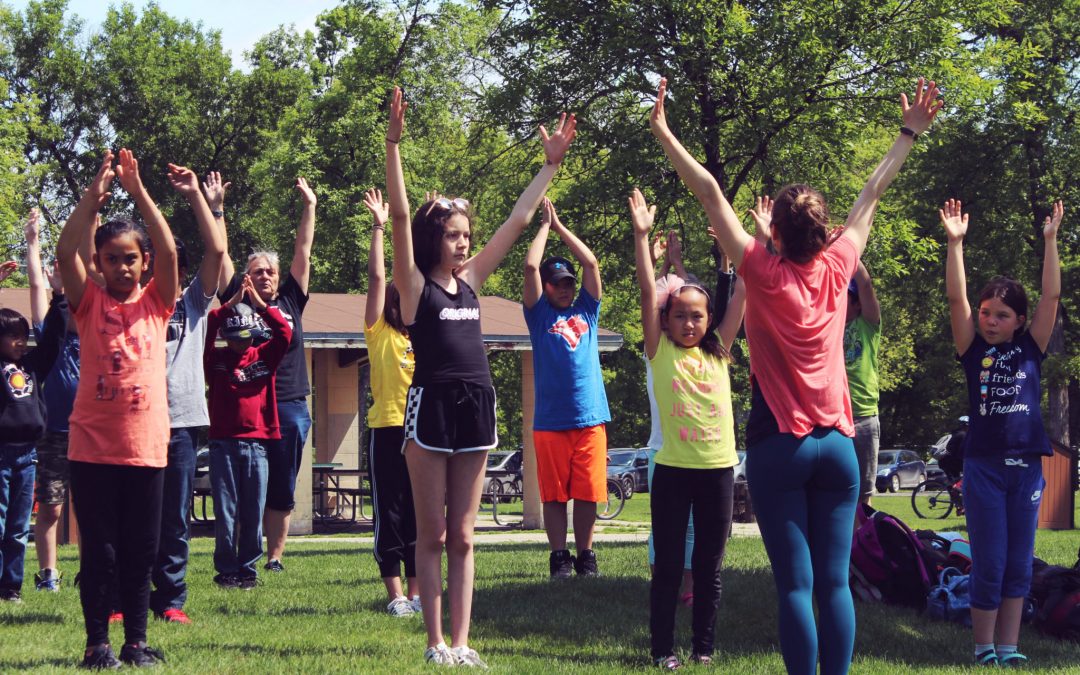In ParticipACTION’s 2018 Report Card, Canadian children scored D+ for physical activity. Only 35% of 5- to-17-year-olds meet the recommended amount of physical activity (2014-15 CHMS, Statistics Canada). We also scored a D- for active transportation. Based on parent- and self-report data, 21% of Canadian youth typically use active modes of transportation, while 63% use inactive modes (2014-16 CANPLAY, CFLRI). In our Making Children Count report, we found that only 1 in 3 students walk/wheel to school in Manitoba. As a result, we’re seeing higher rates of inactivity and health concerns.

Photo Credit: ParticipACTION
This is especially disappointing considering the abundance of research that demonstrates the many benefits of physical activity for children, including improved heart health, maintaining a healthy body weight, building strong bones and muscles, and improved sleep. ParticipACTION’s 2018 Report Card found a growing body of evidence on physical activity and healthy brain, which leads to improved thinking and learning, emotional regulation and self-control, problem-solving ability, memory, brain plasticity (growth of new brain tissue), stress management, ability to cope with anxiety, depressive symptoms, self-esteem and self-worth, and attention and focus. Learn more by reading the full report.
We know we need to improve physical activity rates and health outcomes. We also know the reasons why. The following resources are how to do so!
Planning for Healthy Schools
Healthy Schools is Manitoba’s school health initiative designed to promote the physical, emotional and social health of school communities. It is based on the belief that good health is important for learning and that schools are in a unique position to have a positive influence on the health of children, youth and their families. Healthy Schools has identified six health topics as priorities within the school community:
Becoming a Healthy School
A healthy school promotes the physical, emotional, and social health of students, their families, school staff, and the school community. Becoming a healthy school is a journey that can start with a few simple changes. The approach does not require more work, just a different way of working that over time becomes everyday practice.
Schools work at their own pace, introducing changes and initiatives that improve their school and the health and wellbeing of students and staff. Some schools start with an emphasis on one health topic, such as physical activity or healthy eating. This can lead to a broader set of policies and practice which, combined, create a school culture that supports greater student health and achievement.
Healthy school initiatives are more successful if they involve everyone – school leaders, students and their families, staff and the whole school community. When there is leadership support and everyone is committed, health promoting activities can be well planned, coordinated, implemented, and sustainable over the long-term.
See the six basic steps to becoming a Healthy School here!
Healthy School Planner
The Healthy School Planner is an online tool designed to help Canadian schools create healthier environments. It offers individual schools a way to assess the overall state of their environment as well as the choice to further explore one or more specific topics such as healthy eating, physical activity, positive mental health or tobacco.
Schools can use the Healthy School Planner at any time to assess and build a plan for improving the health of the school. The Planner guides schools through a step-by-step process that includes:
- a series of questions to determine the school’s current health status;
- a rubric of the school’s results;
- a planning template to help develop goals and an action plan for making improvements;
- recommendations for taking action; and
- links to resources to help develop and implement the action plan.
- About the Healthy School Planner

- Click here to use the Healthy School Planner
![]()
Improving Active School Travel Rates
It takes support from all levels: families, schools, and decision makers.
Families:
- Organize a Walking School Bus or Bike Train in your school community.
- Talk to school administration about prioritizing active school travel.
- Ask your local councillor and MLA to support active transportation policy and infrastructure.
- Flex your schedule to include walking or biking your child to school, or park and walk partway.
Schools & Divisions:
- Organize and support walking and cycling programs, with the necessary infrastructure (bike racks/cages).
- Participate in International Walk to School Month, Bike to School Month, and Clean Air Day.
- Develop School Travel Plans that address barriers to active transportation, led by a Divisional Active Transportation Coordinator.
- Implement active transportation policies, including anti-idling policies which encourage drivers and school bus drivers to curb fuel consumption.
Decision Makers:
- Create and adopt policies that prioritize active school travel.
- Prioritize active transportation infrastructure that works for all ages.
- Restructure school transportation budgets to include active transportation.
- Financially support school divisions in the development of School Travel Plans, including implementation and infrastructure funds.
To learn more about active school travel, visit our Active and Safe Routes to School page.










Recent Comments